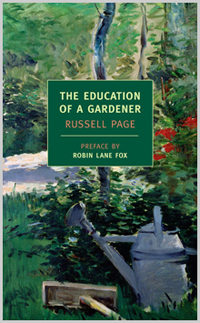Julie recommends The Education of a Gardener by Russell Page:
 It’s easy to imagine Russell Page (1906-1985), author of The Education of a Gardener, holding his thumb up to a distant hill to assess where to plant a cluster of ancient lemon trees. Where a landscape painter is concerned primarily with light, Page must take into account the elements of sun, water, wind, soil, seasonal changes as well as sensory concerns: How might citrus aromas blend with nearby lavender and lilac? How might a box hedge in the background make the yellow fruit pop? Difficult to define—gardener, landscape architect, artist, sage, Page is all these and more. He is the creator of living breathing “pictures,” as he calls them, so that wherever you happen to stand, plants are in harmony with each other, with the landscape, and with you the observer.
It’s easy to imagine Russell Page (1906-1985), author of The Education of a Gardener, holding his thumb up to a distant hill to assess where to plant a cluster of ancient lemon trees. Where a landscape painter is concerned primarily with light, Page must take into account the elements of sun, water, wind, soil, seasonal changes as well as sensory concerns: How might citrus aromas blend with nearby lavender and lilac? How might a box hedge in the background make the yellow fruit pop? Difficult to define—gardener, landscape architect, artist, sage, Page is all these and more. He is the creator of living breathing “pictures,” as he calls them, so that wherever you happen to stand, plants are in harmony with each other, with the landscape, and with you the observer.
I didn’t read Page’s book because I have a deep interest in gardening (it’s quite superficial—if by gardening you count a small, dysfunctional family of houseplants), but because from page one (oh dear, a pun) I was swept away by his passionate lyricism. With modest directness, he writes:
I know that I cannot make anything new. To make a garden is to organize all the elements present and add fresh ones, but first of all, I must absorb as best I can all that I see, the sky, and the skyline, the soil, the colour of the grass and the shape and nature of the trees.
This is from the first chapter, “In search of style,” and I quickly began to absorb Page’s sentences as teachings on the broader categories of beauty, aesthetics, and craftsmanship. It seemed certain lines could be applied to my own artistic undertaking—poetry.
A serious composition cannot depend on intuition or on an intellectual concept alone. All the objects you are going to place require careful study. If it is a plant you must know its size, habit, colour, texture and cultural requirements as well as its place of origin, its history and the way it has been used whether commonly or uncommonly.
Replace “plant” with “word” and you have brilliant advice on the precision of language. There’s something about Page’s bountiful spirit and gorgeous use of language that both delights and inspires—so many times I felt this great sense of broadening within my skull—a student again, I listen with rapt attention.
You have only to take a magnifying glass to a wild orchid or columbine, to the smallest plant of primula or androsace and, at once, strength, will, design, colour and a tremendous rational simplicity invades eye and mind.
It took me months to read Education, which I kept at my bedside, because it was so densely packed with Latinate beauty—Stravanesia undulata and Y. filamentosa—it proved hard to sustain a rapid reading clip. My sleep was likely better for all the lush language: “the prostrate and horizontally growing junipers are wonderful evergreens for massing in full sun.” And the playful names for flowers, too: pinks, catmints, rue, zinnias, nemophilas, larkspur, sweet sultan, and my favorite, “bachelor’s buttons” (cornflowers).
Can I admit that it was also hard to finish Education because it would be like saying goodbye to a new friend? Page reveals very little about himself in the book proper, but there are moments when I genuinely felt I knew him. I particularly loved when he made clear his dislikes: “rhododendron addicts,” nude statues, and round swimming pools. He uses quotes to mention a prototypical showroom-style “American” garden. I laughed aloud when I read the sentence:
Central Park in New York was designed by Olmsted as a nineteenth-century pastiche of an eighteenth-century landscape park.
Page devoted his life to creating picturesque settings, and it saddens me that he wasn’t called on to design a public park because he would have considered every detail imaginable. A man The Telegraph called “the most famous garden designer no one’s ever heard of” would have fulfilled his aim “to lift people, if only for a moment, above their daily preoccupations” as he believed that “even a glimpse of beauty outside will enable them to make a healing contact with their own inner world.”
While there’s still time, see every Page garden you can. If you’re in New York see his garden at the Frick, which has been in a precarious state for the last few years. If you happen to be in Purchase, NY see the Donald M. Kendall Sculpture Garden at the PepsiCo headquarters. See the Anne Bass Garden in Fort Worth, Texas if it’s open to the public. Go abroad. See them all, as seasons shift and change—the best galleries are outdoors.
